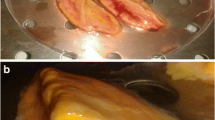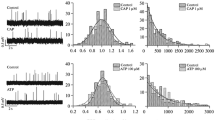Summary
Tetanus and botulinum A neurotoxins inhibited exocytosis evolved by various secretagogues in intact and permeabilized chromaffin cells. The block of exocytosis in intact chromaffm cells due to botulinum A neurotoxin could partially be overcome by enhancing nicotine- and veratridine-induced stimulation, whereas the block due to tetanus toxin persisted under the same conditions. The receptor-mediated restoration of 3H-noradrenaline release was specific for nicotinic stimulation, because exocytosis did not occur during muscarinic stimulation. Depolarization of intact chromaffin cells with increasing concentration of K+ failed to restore exocytosis that had been blocked by either toxin.
When chromaffin cells, treated with tetanus or botulinum A neurotoxins, were exposed to the Ca2+-ionophore A 23187 or permeabilized by staphylococcal α-toxin, Ca2+-stimulated exocytosis was also inhibited. The inhibition was unaffected by increasing concentrations of free Ca2+. Activation of proteinkinase C and of G-proteins by phorbolester and GMPPNHP, respectively, increased Ca2+-induced exocytosis in control cells as well as in cells treated with tetanus and botulinum A neurotoxins. The block, however, could not be relieved by these manipulations, and it could not be relieved by activating the cGMP or cAMP pathways with analoga of cyclic nucleotides, phosphodiesterases inhibitors, and forskolin either.
It is concluded that nicotine and veratridine trigger a mechanism within the sequence of events leading to exocytosis that is located beyond the increase in intracellular Ca2+-concentration. This pathway may not be affected by botulinum A neurotoxin. The target of tetanus toxin is probably located even closer to the fusion process, i. e. beyond the step upon which botulinum A neurotoxin acts.
Similar content being viewed by others
References
Ahnert-Hilger G, Glossmann H, Habermann E (1979) Effects of ion channel toxins on the cyclic nucleotide content of cerebellar slices, primary brain cultures and neuronal cell lines. Naunyn-Schmiedeberg's Arch Pharmacol 307:151 -157
Ahnert-Hilger G, Mach W, Föhr KJ, Gratzl M (1989a) Poration by alpha-toxin and streptolysin O: An approch to analyze intracellular processes. Methods Cell Biol 31:63–90
Ahnert-Hilger G, Weller U, Dauzenroth ME, Habermann E, Gratzl M (1989b) The tetanus toxin light chain inhibits exocytosis. FEBS Lett 242:245–248
Ashton AC, Dolly JO (1991) Microtubule-dissociating drugs and A 23187 reveal differences in the inhibition of synaptosomal transmitter release by botulinum neurotoxins types A and B. J Neurochem 56:827–835
Aunis D, Bader M (1988) The cytoskeleton as a barrier to exocytosis. J Exp Biol 139:253–266
Bader M-F, Sontag J-M, Thierse D, Aunis D (1989) A reassessment of guanine nucleotide effects on catecholamine secretion from permeabilized chromaffin cells. J Biol Chem 264:16426–16434
Bartels F, Marxen P, Bigalke H (1990) Translocation of tetanus toxin into intact and permeabilized chromaffin cells: a comparison. Biol Chem Hoppe-Seyler S371:1035–1036
Bergey GK, Bigalke H, Nelson P (1987) Differential effects of tetanus toxin on inhibitory and excitatory synpatic transmission in mammalian spinal cord neurons in culture: A presynaptic locus of action. J Neurophysiol 57:121–131
Bigalke H, Ahnert-Hilger G, Habermann E (1981 a) Tetanus toxin and botulinum A toxin inhibit acetylcholine release from but not calcium uptake into brain tissue. Naunyn-Schmiedeberg's Arch Pharmacol 316:143–148
Bigalke H, Heller I, Bizzini B, Habermann E (1981 b) Tetanus and botulinum A toxin inhibit release and uptake of various transmitters, as studied with particulate preparations from rat brain and spinal cord. Naunyn-Schmiedeberg's Arch Pharmacol 316:244–251
Bigalke H, Dreyer F, Bergey G (1985) Botulinum A neurotoxin inhibits non-cholinergic transmission in mouse spinal cord neurons in culture. Brain Res 360:318–324
Bigalke H, Müller H, Dreyer F (1986) Botulinum A neurotoxin unlike tetanus toxin acts via a neuraminidase sensitive structure. Toxicon 24:1065–1074
Bigalke H, Marxen P, Ahnert-Hilger G (1989) Restoration of noradrenaline release by increasing concentrations of carbachol in botulinum A neurotoxin blocked chromaffin cells in culture. Biol Chem Hoppe-Seyler S370:993
Binz T, Eisel U, Kurazono H, Binscheck T, Bigalke H, Niemann H (1990) Tetanus and botulinum A toxins: Comparison of sequences and microinjection of tetanus toxin A subunit-specific mRNA into bovine chromaffin cells. In: Rappuoli R, Alouf JE, Falmagne P, Fehrenbach FJ, Gross J, Jeljaszewicz J, Montecucco C, Tomasi M, Wadstr6m T, Witholt B (eds) Bacterial protein toxins. ZbI Bakt [Suppl] 19:105–108
Bittner MA, Holz RW (1988) Effects of tetanus toxin on catecholamine release from intact and digitonin permeabilized chromaffin cells. J Neurochem 51:451–456
Bittner MA, Holz RW, Neubig RR (1986) Guanine nucleotide effects on catecholamine secretion from digitonin-permeabilized chromaffin cells. J Biol Chem 261:10182–10188
Bittner MA, DasGupta BR, Holz RW (1989) Isolated light chains of botulinum neurotoxins inhibit exocytosis. J Biol Chem 264:10354–10360
Burgoyne RD, Morgan A, O'Sullivan AJ (1988) A major role for protein kinase C in calcium-activated exocytosis in permeabilized adrenal chromaffin cells. FEBS Lett 238:151–155
Dreyer F (1989) Peripheral actions of tetanus toxin. In: Simpson LL (ed) Botulinum neurotoxin and tetanus toxin. Academic Press, London, pp179–202
Dreyer F, Schmitt A (1981) Different effects of botulinum A toxin and tetanus toxin on the transmitter releasing process at the mammalian neuromuscular junction. Neurosci Lett 26:307–311
Dreyer F, Rosenberg F, Becker C, Bigalke H, Penner R (1987) Differential effects of various secretagogues on quantal transmitter release from mouse nerve terminals treated with botulinum A and tetanus toxin. Naunyn-Schmiedeberg's Arch Pharmacol 335:1–7
Föhr KJ, Warchol W, Gratzl M (1991) Calculation and control of the divalent cations in solutions used for membrane fusion studies. In: Duzdiingers N (ed) Methods in enzymology: techniques in membrane fusion. Academic Press, London, in press
Gansel M, Penner R, Dreyer F (1987) Distinct sites of action of clostridial neurotoxins revealed by double-poisoning of mouse motor nerve terminals. Pflüger's Arch 409:533–539
Habermann E (1989) Clostridial neurotoxins and the central nervous system: Functional studies on isolated preparations. In: Simpson LL (ed) Botulinum neurotoxin and tetanus toxin. Academic Press, London, pp 255–279
Halpern JL, Habig WH, Trenchard H, Russel JT (1990) Effect of tetanus toxin on oxytocin and vasopressin release from nerve endings of the neurohypophysis. J Neurochem 55:2072–2078
Knight DE (1986) Botulinum toxin type A, B and D inhibit catecholamine secretion from bovine adrenal medullary cells. FEBS Lett 207:222–229
Knight DE, Baker PF (1985) Guanine nucleotides and Ca2+-dependent exocytosis. Studies on two adrenal cell preparations. FEBS Lett 189:345–349
Knight DE, Sudgen D, Baker PF (1988) Evidence implicating protein kinase C in exocytosis from electropermeabilized bovine chromaffin cells. J Membr Biol 104:21–34
Lind I, Ahnert-Hilger G, Fuchs G, Gratzl M (1987) Purification of α-toxin from Staphylococcus aureus and application to cell permeabilization. Anal Biochem 164:84–89
Marley PD (1988) Desensitization of the nicotinic secretory response of adrenal chromaffin cells. TIPS 9:102–107
Marxen P, Bigalke H (1989) Tetanus toxin: Inhibitory action in chromaffin cells is initiated by specified types of gangliosides and promoted in low ionic strength solution. Neurosci Lett 107:261–266
Marxen P, Bigalke H (1991) Tetanus and botulinum A toxins inhibit stimulated F-actin rearrangement in chromaffin cells. Neuroreport 2:33–37
Marxen P, Fuhrmann U, Bigalke H (1989) Gangliosides mediate inhibitory effects of tetanus and botulinum A neurotoxin on exocytosis in chromaffin cells. Toxicon 27:849–859
Marxen P, Ahnert-Hilger G, Wellhöner HH, Bigalke H (1990) Tetanus antitoxin binds to intracellular tetanus toxin in permeabilized chromaffin cells without restoring Ca2+-induced exocytosis. Toxicon 28:1077–1082
Marxen P, Erdmann G, Bigalke H (1991) The translocation of botulinum A neurotoxin by chromaffin cells is promoted in low ionic strength solution and is insensitive to trypsin. Toxicon 29:181–189
Nakov R, Habermann E, Hertting G, Wurster S, Allgaier C (1989) Effects of botulinum A toxin on presynaptic modulation of evoked transmitter release. Eur J Pharmacol 164:45–53
Pocotte SL, Frye RA, Senter DR, TerBush DR, Lee SA, Holz RW (1985) Effects of phorbol ester on catecholamine secretion and protein phosphorylation in adrenal chromaffin cells. Proc Natl Acad Sci USA 82:930–934
Penner R, Neher E, Dreyer F (1986) Intracellularly injected tetanus toxin inhibits exocytosis in bovine adrenal chromaffin cells. Nature 324:76–78
Sandberg K, Berry CJ, Eugster E, Rogers TB (1989) A role of cGMP during tetanus toxin blockade of acetylcholine release in the rat pheochromocytoma (PC 12) cell line. J Neurosci 9:3946–3954
Sasakawa N, Nakaki T, Yamamoto S, Kato R (1987) Inositol triphosphate accumulation by high potassium stimulation in cultured adrenal chromaffin cells. FEBS Lett 223:413–416
Sontag JM, Aunis D, Bader M-F (1988) Peripheral actinfilaments control calcium-mediated catecholamine release from streptolysin-O-permeabilized chromaffin cells. J Cell Biol 46:316–326
Stecher B, Gratzl M, Ahnert-Hilger G (1989a) Reductive chain separation of botulinum A toxin a prerequisite to its inhibitory action on exocytosis in chromaffin cells. FEBS Lett 248:23–27
Stecher B, Weller U, Habermann E, Gratzl M, Ahnert-Hilger G (1989b) The light chain but not the heavy chain of botulinum A toxin inhibits exocytosis from permeabilized adrenal chromaffin cells. FEBS Lett 255:391–394
Stoer SJ, Smolen JE, Holz RW, Agranoff BW (1986) Inositol triphosphate mobilizes intracellular calcium in permeabilized adrenal chromaffin cells. J Neurochem 46:637–640
Stryer C, Bourne H (1986) G-proteins: a family of signal transducers. Ann Rev Cell Biol 2:391–419
TerBush D, Holz RW (1986) Effects of phorbolesthers, diglyceride, and cholinergic agonists on the subcellular distribution of protein kinase C in intact or digitonin-permeabilized adrenal chromaffin cells. J Biol Chem 261:17099–17106
Vesterberg O, Wadstrom T, Vesterberg K, Svennson H, Malmgren B (1967) Studies on extracellular proteins from Staphylococcus aureus. I. Separation and characterization of enzymes and toxins by isoelectric focusing. Biochim Biophys Acta 133:435–445
Wellhöner HH, Neville D (1987) Tetanus toxin binds with high affinity to neuroblastoma × glioma NG 108–15 and impairs their stimulated acetylcholine release. J Biol Chem 292:17374–17378
Author information
Authors and Affiliations
Additional information
Send offprint requests to H. Bigalke at the above address
Rights and permissions
About this article
Cite this article
Marxen, P., Bartels, F., Ahnert-Hilger, G. et al. Distinct targets for tetanus and botulinum A neurotoxins within the signal transducing pathway in chromaffin cells. Naunyn-Schmiedeberg's Arch Pharmacol 344, 387–395 (1991). https://doi.org/10.1007/BF00172577
Received:
Accepted:
Issue Date:
DOI: https://doi.org/10.1007/BF00172577




